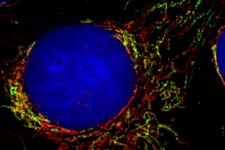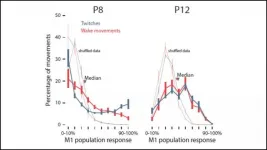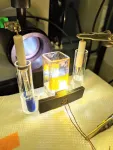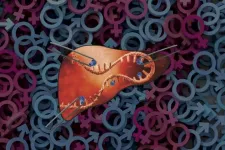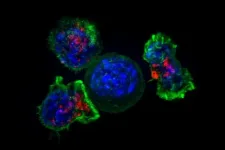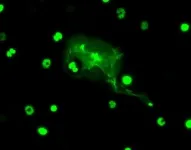Curtin study challenges recommended wait time between pregnancies
2021-07-19
New Curtin University-led research has called into question existing health advice that mothers wait a minimum of two years after giving birth to become pregnant again, in order to reduce the risk of adverse pregnancy outcomes, such as preterm and small-for-gestational age births.
The research found that a World Health Organization (WHO) recommendation to wait at least 24 months to conceive after a previous birth may be unnecessarily long for mothers in high-income countries such as Australia, Finland, Norway and the United States.
Lead researcher ...
How cells control mitochondria
2021-07-19
Errors in the metabolic processes of mitochondria are responsible for a variety of diseases such as Parkinson's and Alzheimer's. Scientists needed to find out just how the necessary building blocks are imported into the complex biochemical apparatus of these cell areas. The TOM complex (translocase of the outer mitochondrial membrane) is considered the gateway to the mitochondrion, the proverbial powerhouse of the cell. The working group headed by Professor Chris Meisinger at the Institute of Biochemistry and Molecular Biology at the University of Freiburg has now demonstrated - in human cells - how signaling molecules control this gate. A signaling protein called DYRK1A modifies the molecular machinery of TOM and makes it more permeable ...
When money's tight, parents talk less to kids; could this explain the word gap?
2021-07-19
Three decades ago, child development researchers found that low-income children heard tens of millions fewer words in their homes than their more affluent peers by the time they reached kindergarten. This "word gap" was and continues to be linked to a socioeconomic disparity in academic achievement.
While parenting deficiencies have long been blamed for the word gap, new research from the University of California, Berkeley, implicates the economic context in which parenting takes place -- in other words, the wealth gap.
The findings, published this month in the journal Developmental Science, provide the first evidence that parents may talk less to their kids when experiencing financial scarcity.
"We were interested in what happens when parents think about or experience financial scarcity ...
Sleep twitches facilitate motor cortex development in rats
2021-07-19
Electrical activity in the motor cortex of rats transforms from redundant to complex over the span of four days shortly after birth. Sleep twitches guide this metamorphosis, according to new research published in JNeurosci.
Despite its name, the motor cortex doesn't control movement right off the bat. Early in development, this part of the brain is solely a sensory structure. Feedback from self-generated movements -- sleep twitches in particular -- may build representations of the body that will later orchestrate movement.
To characterize this transition, Glanz et al. recorded electrical activity from the motor cortex of rat pups eight and 12 days after birth while monitoring their behavior. ...
Angry politicians make angry voters, new study finds
2021-07-19
Politicians may have good reason to turn to angry rhetoric, according to research led by political scientists from Colorado--the strategy seems to work, at least in the short term.
In a new study, Carey Stapleton at the University of Colorado Boulder and Ryan Dawkins at the U.S. Air Force Academy discovered that political furor may spread easily: Ordinary citizens can start to mirror the angry emotions of the politicians they read about in the news. Such "emotional contagion" might even drive some voters who would otherwise tune out of politics to head to the polls.
"Politicians want to get reelected, and anger is a powerful tool that they can use to make that happen," said Stapleton, who recently earned his PhD in political science at ...
Study may show why MS patients develop progressive disability
2021-07-19
ROCHESTER, Minn. -- Did you know multiple sclerosis (MS) means multiple scars? New research shows that the brain and spinal cord scars in people with MS may offer clues to why they developprogressive disability but those with related diseases where the immune system attacks the central nervous system do not.
In a study published in Neurology, Mayo Clinic researchers and colleagues assessed if inflammation leads to permanent scarring in these three diseases:
MS.
Aquaporin-4 antibody positive neuromyelitis optica spectrum disorder (AQP4-NMOSD).
Myelin oligodendrocyte glycoprotein antibody associated disorder (MOGAD).
They also studied whether scarring may be a reason for ...
Making clean hydrogen is hard, but researchers just solved a major hurdle
2021-07-19
For decades, researchers around the world have searched for ways to use solar power to generate the key reaction for producing hydrogen as a clean energy source -- splitting water molecules to form hydrogen and oxygen. However, such efforts have mostly failed because doing it well was too costly, and trying to do it at a low cost led to poor performance.
Now, researchers from The University of Texas at Austin have found a low-cost way to solve one half of the equation, using sunlight to efficiently split off oxygen molecules from water. The finding, published recently in Nature Communications, represents a step forward toward greater adoption ...
DNA duplication linked to the origin and evolution of pine trees and their relatives
2021-07-19
GAINESVILLE, Fla. --- Plants are DNA hoarders. Adhering to the maxim of never throwing anything out that might be useful later, they often duplicate their entire genome and hang on to the added genetic baggage. All those extra genes are then free to mutate and produce new physical traits, hastening the tempo of evolution.
A new study shows that such duplication events have been vitally important throughout the evolutionary history of gymnosperms, a diverse group of seed plants that includes pines, cypresses, sequoias, ginkgos and cycads. Published today in Nature Plants, the research indicates that ...
RNA modification may protect against liver disease
2021-07-19
FINDINGS
A chemical modification that occurs in some RNA molecules as they carry genetic instructions from DNA to cells' protein-making machinery may offer protection against non-alcoholic fatty liver, a condition that results from a build-up of fat in the liver and can lead to advanced liver disease, according to a new study by UCLA researchers.
The study, conducted in mice, also suggests that this modification -- known as m6A, in which a methyl group attaches to an RNA chain -- may occur at a different rate in females than it does in males, potentially explaining why females tend to have higher fat content in the liver. The researchers found that without the m6A modification, differences in liver fat content between the sexes were reduced dramatically.
In ...
Ocean microbes team up brilliantly to gather food when it's scarce
2021-07-19
WOODS HOLE, Mass. - What's a hungry marine microbe to do when the pickings are slim? It must capture nutrients - nitrogen, phosphorus, or iron - to survive, yet in vast expanses of the ocean, nutrients are extremely scarce. And the stakes are high: Marine microbial communities drive many of the elemental cycles that sustain all life on Earth.
One ingenious solution to this challenge is reported this week in Proceedings of the National Academy of Sciences. In low-nutrient environments, marine microbes can clump together and hook up with even tinier cells that have vibrating, hairlike appendages (cilia) on their surface. ...
Robotic neck brace can help analyze cancer treatment impacts
2021-07-19
New York, NY--July 19, 2021-- A new robotic neck brace from researchers at Columbia Engineering and their colleagues at Columbia's Department of Otolaryngology may help doctors analyze the impact of cancer treatments on the neck mobility of patients and guide their recovery.
Head and neck cancer was the seventh most common cancer worldwide in 2018, with 890,000 new cases and 450,000 deaths, accounting for 3% of all cancers and more than 1.5% of all cancer deaths in the United States. Such cancer can spread to lymph nodes in the neck, as well as other organs in the body. Surgically removing lymph nodes in the neck can help doctors investigate the risk of spread, but may result in pain and stiffness in the shoulders and neck for years afterward.
Identifying ...
For concussion patients, CTs offer window into recovery
2021-07-19
CT scans for patients with concussion provide critical information about their risk for long-term impairment and potential to make a complete recovery - findings that underscore the need for physician follow-up.
In a study led by UC San Francisco, researchers looked at the CT scans of 1,935 patients, ages 17 and over, whose neurological exams met criteria for concussion, or mild traumatic brain injury (TBI), at hospitals throughout the nation. While links between CT imaging features and outcome have already been established in moderate and severe TBI, the researchers believe this is the first time the link has been identified in patients ...
Abelacimab effective blood clot treatment, McMaster-led study shows
2021-07-19
Hamilton, ON (July 19, 2021) - A potentially game-changing treatment for people with, or at risk of, blood clots has been found effective by an international team of researchers led by McMaster University's Jeffrey Weitz.
Weitz's team compared abelacimab with enoxaparin as a control drug in 412 patients undergoing knee replacement surgery. Results showed that just one abelacimab injection prevents blood clots for up to a month after surgery, reducing the risk by about 80% compared with enoxaparin without increasing the risk of bleeding.
Their findings were published in the New England Journal of Medicine today, coinciding with Weitz's presentation of the research at the International Society on Thrombosis and Hemostasis 2021 Congress.
Weitz, a hematologist, is a professor of medicine ...
Examining association between cycling, risk of death among people with diabetes
2021-07-19
What The Study Did: This study investigated the association between time spent cycling and the risk of death from cardiovascular disease or any other cause among people with diabetes.
Authors: Mathias Ried-Larsen, Ph.D., of Rigshospitalet in Copenhagen, is the corresponding author.
To access the embargoed study: Visit our For The Media website at this link https://media.jamanetwork.com/
(doi:10.1001/jamainternmed.2021.3836)
Editor's Note: The article includes conflicts of interest and funding/support disclosures. Please see the article for additional information, including other authors, author contributions and affiliations, conflict of interest and financial disclosures, and funding and support.
# # #
Media advisory: The full study and editor's note are ...
Transgender young people accessing health care
2021-07-19
What The Study Did: The experiences, perspectives and needs of transgender young people in accessing health care are described in this review of 91 studies.
Authors: Lauren S. H. Chong, M.D., of the Children's Hospital at Westmead in Sydney, Australia, is the corresponding author.
To access the embargoed study: Visit our For The Media website at this link https://media.jamanetwork.com/
(doi:10.1001/jamapediatrics.2021.2061)
Editor's Note: The article includes conflict of interest disclosures. Please see the article for additional information, including other authors, author contributions and affiliations, conflict of interest and financial disclosures, and funding and support.
# ...
COVID-19-related immigration concerns among Latinx immigrants in US
2021-07-19
What The Study Did: These results suggest that substantial proportions of Latinx immigrants have immigration concerns about engaging in COVID-19-related testing, treatment and contact tracing.
Authors: Carol L. Galletly, J.D., Ph.D., Medical College of Wisconsin in Milwaukee, is the corresponding author.
To access the embargoed study: Visit our For The Media website at this link https://media.jamanetwork.com/
(doi:10.1001/jamanetworkopen.2021.17049)
Editor's Note: The article includes conflict of interest and funding/support disclosures. Please see the article for additional information, including other authors, author contributions and affiliations, conflict of interest and financial disclosures, and funding and support.
# # ...
Coffee and heart beats
2021-07-19
What The Study Did: The association between daily coffee consumption and the risk of cardiac arrhythmias was evaluated in this study.
Authors: Gregory M. Marcus, M.D., M.A.S., of the University of California, San Francisco, is the corresponding author.
To access the embargoed study: Visit our For The Media website at this link https://media.jamanetwork.com/
(doi:10.1001/jamainternmed.2021.3616)
Editor's Note: The article includes conflicts of interest and funding/support disclosures. Please see the article for additional information, including other authors, author contributions and affiliations, conflict of interest and financial disclosures, and funding and support.
# # #
Media advisory: The full study and commentary are ...
Occurrence of young-onset dementia
2021-07-19
What The Study Did: This study included a meta-analysis that combined the results of 74 studies with 2.7 million participants to estimate how common globally dementia is in people younger than age 65.
Authors: Sebastian Köhler, Ph.D., of Maastricht University in Maastricht, the Netherlands, is the corresponding author.
To access the embargoed study: Visit our For The Media website at this link https://media.jamanetwork.com/
(doi:10.1001/jamaneurol.2021.2161)
Editor's Note: The article includes conflicts of interest and funding/support disclosures. Please see the article for additional information, including other authors, author contributions and affiliations, conflict of interest and financial disclosures, and funding and ...
Disparities in outpatient visit rates
2021-07-19
What The Study Did: Researchers examined racial/ethnic disparities in outpatient visit rates to 29 physician specialties in the United States.
Authors: Christopher Cai, M.D., of the Internal Medicine Residency Program at Brigham and Women's Hospital/Harvard Medical School in Boston, is the corresponding author.
To access the embargoed study: Visit our For The Media website at this link https://media.jamanetwork.com/
(doi:10.1001/jamainternmed.2021.3771)
Editor's Note: The article includes conflicts of interest disclosures. Please see the article for additional information, including other authors, author contributions and affiliations, conflict of interest and financial disclosures, and funding and support.
INFORMATION:
Media advisory: The full study is linked to this news release.
Embed ...
EHT pinpoints dark heart of the nearest radio galaxy
2021-07-19
An international team anchored by the Event Horizon Telescope (EHT) Collaboration, which is known for capturing the first image of a black hole in the galaxy Messier 87, has now imaged the heart of the nearby radio galaxy Centaurus A in unprecedented detail. The astronomers pinpoint the location of the central supermassive black hole and reveal how a gigantic jet is being born. Most remarkably, only the outer edges of the jet seem to emit radiation, which challenges our theoretical models of jets. This work, led by Michael Janssen from the Max Planck Institute for Radio Astronomy ...
Preparing T cells for the long haul
2021-07-19
LA JOLLA--Fighting a tumor is a marathon, not a sprint. For cancer-fighting T cells, the race is sometimes just too long, and the T cells quit fighting. Researchers even have a name for this phenomenon: T cell exhaustion.
In a new Nature Immunology study, researchers at La Jolla Institute for Immunology (LJI) report that T cells can be engineered to clear tumors without succumbing to T cell exhaustion.
"The idea is to give the cells a little bit of armor against the exhaustion program," says LJI Professor Patrick Hogan, Ph.D. "The cells can go into the tumor to do their job, ...
Researchers discover how cancer cells that spread to lymph nodes avoid immune destruction
2021-07-19
BOSTON - Lymph nodes are critical to the body's immune response against tumors but paradoxically, cancer cells that spread, or metastasize, to lymph nodes can often avoid being eliminated by immune cells. Recent experiments by investigators at Massachusetts General Hospital (MGH) and Boston University School of Medicine provide insights on the details behind this immune evasion, which could help scientists develop strategies to overcome it. The findings are published in Nature Biomedical Engineering.
"We know that lymph nodes are often the first place cancer ...
USC study shows male-female differences in immune cell function
2021-07-19
A new USC study of a common, yet poorly understood type of white blood cell reveals the immune cell's response to pathogens differs greatly by sex and by age.
In this mouse study, males proved much more susceptible to a condition called sepsis than females. However, the scientists also found that the female disease-defense system is hardly perfect; their system changes with age to become nearly as harmful as the males'.
Those are the key findings in a study that appears today in Nature Aging.
The study has important implications for studying disease and cures, especially for sepsis, a condition in which the body's defense ...
NIH-funded study shows imaging after mild brain injury may predict outcomes
2021-07-19
WHAT:
A new study published in JAMA Neurology suggests that certain features that appear on CT scans help predict outcomes following mild traumatic brain injury (TBI). Patterns detected on the scans may help guide follow up treatment as well as improve recruitment and research study design for head injury clinical trials.
Researchers led by Geoffrey Manley, M.D., Ph.D., professor of neurological surgery at the University of California San Francisco, conducted CT scans in 1,935 subjects with mild TBI and followed their outcomes up to 12 months after injury.
This research was part of the Transforming Research and Clinical Knowledge in Traumatic Brain Injury (TRACK-TBI) study, a large research effort funded by the National Institutes of ...
Why is the eastern monarch butterfly disappearing?
2021-07-19
Michigan State University ecologists led an international research partnership of professional and volunteer scientists to reveal new insights into what's driving the already-dwindling population of eastern monarch butterflies even lower.
Between 2004 and 2018, changing climate at the monarch's spring and summer breeding grounds has had the most significant impact on this declining population. In fact, the effects of climate change have been nearly seven times more significant than other contributors, such as habitat loss. The team published its report July 19 in the journal Nature Ecology & Evolution.
"What we do is develop models to understand why monarchs are declining ...
[1] ... [1990]
[1991]
[1992]
[1993]
[1994]
[1995]
[1996]
[1997]
1998
[1999]
[2000]
[2001]
[2002]
[2003]
[2004]
[2005]
[2006]
... [8705]
Press-News.org - Free Press Release Distribution service.
